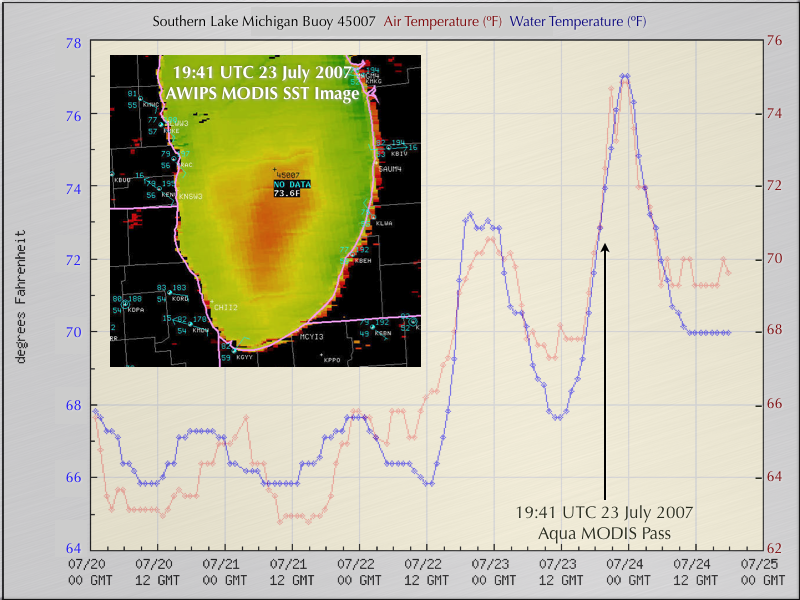
[ Archive ]

 |
ASPB and CIMSS Weekly Report
[ Archive ] |
 |
IN THE PRESS:
ITEMS FOR THE ADMINISTRATOR:
ITEMS FOR THE ASSISTANT ADMINISTRATOR:
ITEMS FOR THE OFFICE DIRECTOR, STAR:
Paper Published on Possible Causes of Decreasing Cloud Cover in the Arctic Winter: A paper titled "Possible causes of
decreasing cloud cover in the Arctic winter, 1982–2000" was published in Geophysical Research
Letters (34, L14705, doi:10.1029/2007GL030042). The authors are Y. Liu (Cooperative Institute for Meteorological Satellite Studies, CIMSS), J. Key, J. Francis (Rutgers University), and X. Wang (CIMSS). Previous work by the authors used satellite data to demonstrate the decrease in wintertime cloud amount over the central Arctic, in contrast to increasing cloud amount at other times of the year. This paper addresses the possible causes of the wintertime decrease, including moisture advection and changes in cyclonic activity. The paper is available at http://stratus.ssec.wisc.edu/papers/winter_clouds_grl07.pdf. (J. Key, E/RA2,
608-263-2605, jkey@ssec.wisc.edu)
CIMSS Summer Workshop for High School Students: The
15th Cooperative Institute for Meteorological Satellite Studies (CIMSS)
Workshop on Atmospheric, Earth, and Space Sciences was held July 22-26,
2007 on the University of Wisconsin-Madison campus. Seven students from
throughout the northeast quadrant of the U.S. participated in a program
of learning and exploration with hands-on sessions on meteorology and
climate, remote sensing, geology, and astronomy, presented by CIMSS and
other university scientific staff. Field trips included visits to a
local Madison television station (WISC TV-3) weather department; the
local southern Wisconsin National Weather Service (NWS) forecast
office, in Sullivan, WI (Milwaukee); and the Devil's Lake State
Park/Baraboo, WI region. (M. Mooney, CIMSS, 608-265-2123; G.S. Wade,
E/RA2, 608-263-4743, gary.s.wade@noaa.gov)
GOES-13 Data: With Geostationary Operational
Environmental Satellite (GOES)-13 data (brought out of on-orbit storage
for a few weeks of testing and evaluation), a comparison of 1-kilometer
resolution visible channel imagery from GOES-13 and GOES-12
demonstrates how certain features are more evident with the GOES-13
visible data. For example, the network of cities, towns and highways
can be seen in the GOES-13 visible image, especially across
northwestern Iowa and southwestern Minnesota. These towns and roads
show up due to the contrast between the higher albedo of the towns and
road surfaces and the lower albedo of the surrounding fields of dense,
mature corn crops. These features were less apparent in the GOES-12
visible image, in part to the on-orbit visible degradation and in part
to the differing spectral response functions (more reflection from the
vegetated surfaces). The Space Science Engineering Center (SSEC) Data
Center is acquiring the GOES-13 GOES Variable (GVAR) data. More
information can be found at: http://cimss.ssec.wisc.edu/goes/blog/category/goes-13/ (T. Schmit, E/RA2, 608-263-0291, tim.j.schmit@noaa.gov, M. Gunshor, CIMSS, 608-263-1146, S. Bachmeier, CIMSS, 608-263-3958)
ITEMS FOR THE DIVISION CHIEF, CoRP:
MODIS SST Product Shows Rapid Warming of Lake Michigan Waters: Moderate resolution Imaging Spectroradiometer (MODIS) Sea Surface Temperature (SST) imagery revealed a pocket of warmer SST values over the mid-lake waters of southern Lake Michigan on July 23, 2007. This particular warm water feature was not evident on MODIS SST imagery on July 20 or 21, but water temperatures were beginning to increase over that region on July 22. Data from the southern Lake Michigan Buoy 45007 supported this rapid warming trend seen on the MODIS SST imagery. In fact, the buoy water temperature that afternoon warmed at a rate of 1 degree Fahrenheit (F) per hour, with a total rise of 9 degrees F in a 12 hour period. Image examples and animations are available on the Cooperative Institute for Meteorological Satellite Studies (CIMSS) Satellite Blog (http://tinyurl.com/3e3nxr). (S. Bachmeier, CIMSS, 608-263-3958, J. Gerth, CIMSS, 608-263-4942) (Click image to enlarge)
(Click image to enlarge)Other Meetings and Telecons:
None.
VISITORS:
Visitor from CICS: Dr. Daniel Vila of the
Cooperative Institute for Climate Studies (CICS) visited the
Cooperative Institute for Meteorological Satellite Studies (CIMSS) and
the Advanced Satellite Products Branch (ASPB) July 24-25. The topics
discussed included Geostationary Operational Environmental Satellite
(GOES)-10 Sounder status, processing, algorithms, data, training and
web pages. Dr. Vila also gave a seminar entitled “Validation Results
for Daily Precipitation Estimates and MCS Life Cycle over Del Plata
Basin”. He met primarily with T. Schmit and Jun Li. (T. Schmit, E/RA2,
608-263-0291, tim.j.schmit@noaa.gov; J. Li, CIMSS, 608-262-3755; J.
Key, E/RA2, 608-263-2605, jkey@ssec.wisc.edu)
Visitor from CIRA: Aaron Schwartz of the
Cooperative Institute for Research in the Atmosphere (CIRA) visited the
Cooperative Institute for Meteorological Satellite Studies (CIMSS) and
the Advanced Satellite Products Branch (ASPB) July 25-26. Mr. Schwartz,
a graduate student at Colorado State University, came to discuss his
plans for studying the radiative effect of Arctic clouds using CALIPSO
and Cloudsat. He met with M. Pavolonis, X. Wang, Y. Liu, E. Weisz, and
J. Key. (J. Key, E/RA2, 608-263-2605, jkey@ssec.wisc.edu)
GOES-R Algorithm Integration Team Visit: The GOES-R Algorithm Working Group (AWG) Algorithm Integration Team (AIT) visited the Cooperative Institute for Meteorological Satellite Studies (CIMSS) on Wednesday, July 22. Mitch Goldberg (STAR) also visited CIMSS. AIT and CIMSS discussions included GeoCAT, coding standards, and schedules. (W. Feltz, CIMSS, 608-265-6283; J. Key, E/RA2, 608-263-2605, jkey@ssec.wisc.edu)
NEXT WEEK:
LOOKING AHEAD:
| Archived Weeklies Page | Submit a report item |